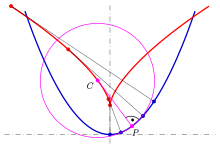
Back منشور منحنى Arabic Еволюта Bulgarian Evoluta Catalan Evolute German Evoluto Esperanto Evoluta Spanish Evoluut Estonian Eboluta Basque Evoluutta Finnish Développée French


In the differential geometry of curves, the evolute of a curve is the locus of all its centers of curvature. That is to say that when the center of curvature of each point on a curve is drawn, the resultant shape will be the evolute of that curve. The evolute of a circle is therefore a single point at its center.[1] Equivalently, an evolute is the envelope of the normals to a curve.
The evolute of a curve, a surface, or more generally a submanifold, is the caustic of the normal map. Let M be a smooth, regular submanifold in Rn. For each point p in M and each vector v, based at p and normal to M, we associate the point p + v. This defines a Lagrangian map, called the normal map. The caustic of the normal map is the evolute of M.[2]
Evolutes are closely connected to involutes: A curve is the evolute of any of its involutes.
- ^ Weisstein, Eric W. "Circle Evolute". MathWorld.
- ^ Arnold, V. I.; Varchenko, A. N.; Gusein-Zade, S. M. (1985). The Classification of Critical Points, Caustics and Wave Fronts: Singularities of Differentiable Maps, Vol 1. Birkhäuser. ISBN 0-8176-3187-9.
© MMXXIII Rich X Search. We shall prevail. All rights reserved. Rich X Search